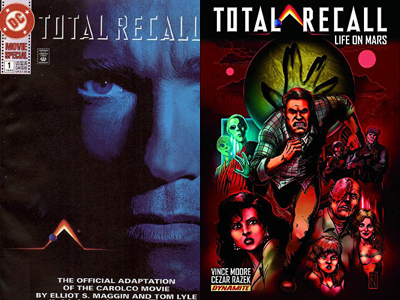Other than “Blade Runner,” “Total Recall” not surprisingly has the most presence on the comic book racks among Philip K. Dick-inspired franchises. First was the 1990 movie adaptation (a double-length issue) from DC, then came the four-issue “Life on Mars” (2011, Dynamite). The timing was weird: 21 years after an original film that wasn’t a hot property, and one year before a remake no one asked for.
A version for kids
The 1990 adaptation comes from writer Elliot S. Maggin, illustrator Tom Lyle and colorist Lovern Knozierski. It’s competent, with good action flow. The fact that it’s in comic form (allowing you to pause when needed) makes the complex plot easier to follow.
Especially nice are a couple of pages with two vertical stacks of action, each a different scene; a reader bounces between them like an intercut film. Lyle’s panoramas of the Mars mining facility and settlement are detailed, and they would open up the oddly claustrophobic film, but they are hurt by the four-color limitation.

“Total Recall” (1990)
DC, double-length issue
Writer: Elliot S. Maggin
Artist: Tom Lyle
Colorist: Lovern Knozierski
Younger readers can experience this adventure, as the swearing and extreme violence are removed. The only notable “different from the movie” element comes when Quaid (Arnold Schwarzenegger’s character) removes his old-lady mask: It’s a soft Halloween-style mask. I don’t know if the special effects of the face/bomb unfolding like a puzzle weren’t completed at the time of Lyle’s drawing or if the DC adaptation was preserving the movie’s surprise.
If you want a peek into earlier versions of the screenplay, you won’t get that here. I recommend Piers Anthony’s novelization. It’s not very good, but it gives details about why the aliens devised the air-making machine featured in the climax.
Recalling the same plot
“Total Recall” got a TV prequel in 1999 with the unrelated (but quite good) “Total Recall 2070” but didn’t get a sequel until 2011’s “Life on Mars.” It’s, um, not exactly worth the wait.
Artist Cezar Razek and colorist Salvatore Aiala crisply bring us back to Mars, and they portray the characters like how they look in the movie. But writer Vince Moore repeats the film’s broad strokes in the way cash-in sequel movies used to do (and sometimes still do). Even by that standard, “Life on Mars” is weak.

“Total Recall: Life on Mars” (2011)
Dynamite, 4 issues
Writer: Vince Moore
Artist: Cezar Razek
Colorist: Salvatore Aiala
In the immediate wake of the film’s events in 2084, there’s a brief pause as both sides of the conflict (Cohaagen’s soldiers and the rebels, which include mutants and other oppressed citizens) appreciate that there’s air on Mars. Then Cohaagen’s son and daughter come from Earth to take over the brutal regime – with a smile – and they restrict another resource – water – in order to get people to fall in line.

That description is somewhat PKD-ish; governments are always going to find a way to assert their power, even if the person at the top or the mechanisms of control change. It makes sense that the Cohaagens don’t want the populace get a taste of freedom: They might learn to like it.
Reaction heroes
The problem with “Life on Mars” is the choppy, repetitive narrative and how Quaid and girlfriend Melina (Rachel Ticotin in the film) navigate the events. Quaid is a reactive hero rather than an action hero, and every piece of action is more forced than in the film, which was already gleefully over the top.
Most notably, Quaid meets Q’D, a mutant who aims to trigger the second and third alien machines. One could surmise they do something good – as with the air-making machine – and this turns out to be the case: Machine No. 2 makes plant life and Machine No. 3 makes oceans and rivers.
But Quaid and Q’D exchange punches even as they have frustrating back-and-forth chats wherein Q’D won’t say what the machines do (for no reason) and Quaid aims to stop him from triggering the machines (out of an unlikely abundance of caution).
Melina is even worse. While she doesn’t really show her resistance-fighter chops in the movie, Melina becomes completely useless in the comic. She just asks Quaid his latest theories about what’s going on. (And those theories are never interesting anyway.)
Distracted by forcing fistfights into the narrative, “Life on Mars” misses a chance for spectacular visuals. Razek and Aiala give us space views of Mars looking verdant, but it would’ve been nice to see panels of plants sprouting and water bursting forth to create this newly green and blue globe.
The Martians are coming
Perhaps inspired by Anthony’s novelization, Moore introduces the Martians (Razek draws them as tall and blue, but essentially in the classic gray alien form). Unlike in the novelization, the aliens’ motivations are completely altruistic: They want to make Mars habitable for humans. That’s nice, but not interesting.
Moore hints at the Martians’ backstory. They accidentally destroyed a fifth planet (the text mistakenly says “fourth planet”), which is now the asteroid belt between Mars and Jupiter; they hibernated on Mars’ two moons; and now they have emerged. They were awaiting the appearance of Quaid – a messiah figure in their inexplicably prescient mythology – to be good hosts to Mars’ settlers.
The comic – which features no Rekall technology and only gives lip service to Quaid’s trust issues about his own memories — ends with a Martian asking the humans if they know anything about a third moon that used to exist. This sets up the next arc that Moore didn’t get to write. After reading “Life on Mars,” it’s unlikely anyone wanted more.
Click here to visit our Philip K. Dick Zone.
“Total Recall” adaptation: 3.5 stars
“Total Recall: Life on Mars”: 2.5 stars

